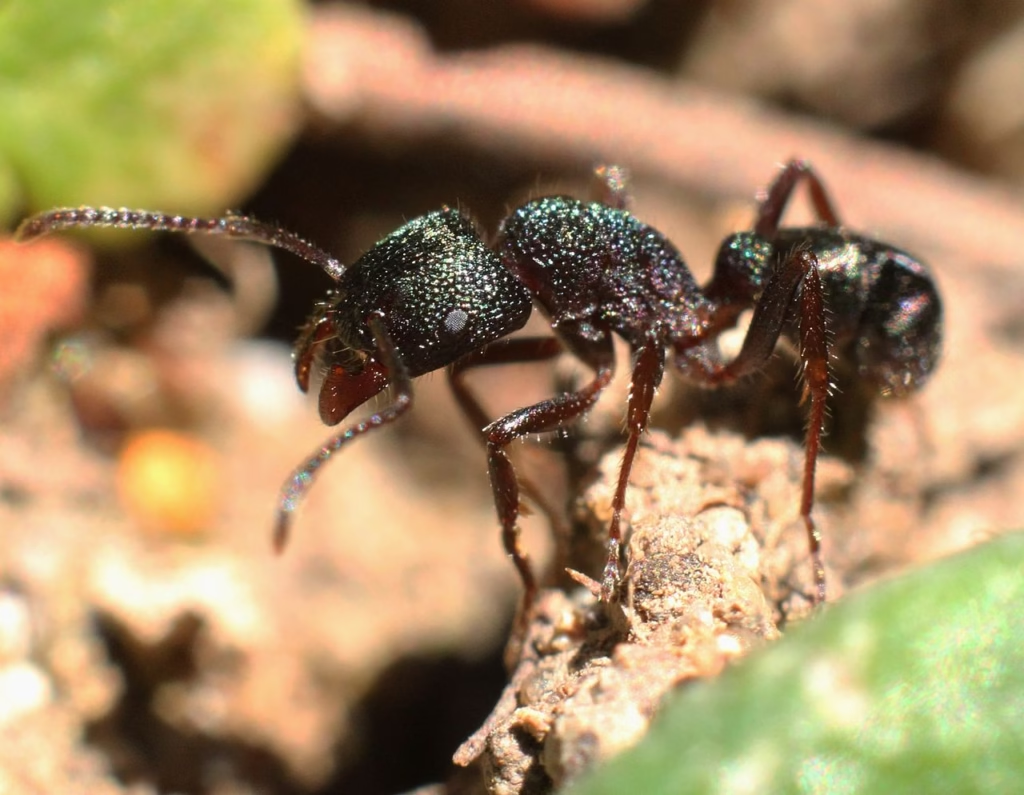Scientific Name: Rhytidoponera metallica
Common Name: Green-Headed Ant
Size: Workers: 5–7 mm | Queens: 6–8 mm
Lifespan: Queens: Up to 2 years | Workers: ~1 year
Colony Type: Gamergate-led (reproductive workers) or rarely monogynous (single queen)
Foraging Activity: Diurnal (Active During the Day)
Natural Habitat: Forests, woodlands, and urban areas across Australia
Nuptial Flight Season: Spring (September–November)
Hibernation: No true hibernation; reduced activity in cooler months
Founding Type: Semi-claustral – Queen (or gamergates) must forage to survive the founding stage.

1. Introduction to Green-Headed Ants
Green-Headed Ant care is rewarding for keepers who enjoy active, fascinating colonies. The Green-Headed Ant (Rhytidoponera metallica) is one of Australia’s most eye-catching species, with a metallic green exoskeleton that sparkles in sunlight. But beauty here comes with a warning — these ants pack a sting that can make you instantly rethink your life choices.
Unlike most ants that rely solely on a queen, R. metallica often runs on a gamergate system, where certain mated workers handle reproduction. Queens do exist but are relatively uncommon, giving this species a flexible and resilient colony structure. They’re fascinating to keep — small, active colonies, interesting behaviour, and a bit of attitude thrown in.
2. Natural Habitat and Distribution
Green-Headed Ants are widespread across mainland Australia (though not in Tasmania) and thrive in a variety of environments:
- Forests and Woodlands – Nesting in soil, under rocks, and within rotting logs.
- Open Grasslands and Heathlands – Often found in sandy, loose soil.
- Urban Areas – Common in gardens, lawns, and even footpaths (where barefoot pedestrians occasionally regret their decisions).
Nesting Preferences:
🐜 Soil nests – Often at the base of plants, under stones, or in rotting wood.
🐜 Small underground chambers – These ants don’t build massive structures.
🐜 Warm, well-drained environments – Avoiding overly wet or boggy conditions.
Ge ants don’t build massive nests.
🐜 Warm, well-drained environments – Avoiding overly humid or wet conditions.
🔗 Related Guide: How to Find Queen Ants in Australia
3. Nuptial Flights – When and Where to Catch a Queen
When Do They Fly?
📅 Peak Season: Spring (September–November)
🌡 Ideal Conditions: Warm, humid days after rainfall
🕑 Time of Day: Afternoon to early evening (around 2 PM – 6 PM)
How to Identify a Queen:
✅ Slightly larger than workers (6–8 mm)
✅ Same metallic green sheen but with a bulkier thorax
✅ Seen wandering alone after a flight, looking for a nest site
💡 Interesting Twist: You don’t always need to catch a queen. In gamergate-led colonies, a mated worker can establish or continue a colony without a queen at all.
🔗 Related Guide: What to Do with a Queen Ant After Capture
4. Founding Stage – How Long in a Test Tube?
Once you catch a queen (or a reproductive worker), you’ll need a proper test tube setup to start the colony.
Test Tube Setup for Founding:
🐜 Test tube (16–20 mm wide, glass or plastic)
🐜 Water reservoir (one-third of the tube, sealed with cotton)
🐜 Cotton plug (for airflow and security)
🐜 Stored in a warm, dark location (24–28 °C)
How Long Until She’s Ready for a Nest?
✅ Wait until at least 15–20 workers are present before moving into a formicarium.
✅ Semi-claustral founders need protein from the start — offer tiny insect pieces early on.
🔗 Related Guide: The Perfect Test Tube Setup for Queen Ants
5. Green-Headed Ant Care – Housing & Nesting Requirements
When it comes to Green-Headed Ant care, housing choice is important for keeping them healthy, contained, and comfortable. Once your colony reaches 15–20 workers, it’s time to move them into a formicarium.
Best Nest Types for Green-Headed Ants:
🏠 Acrylic Nests – Great visibility, easy cleaning.
🏠 3D-Printed Nests – Customisable, excellent for small colonies.
🏠 Ytong Nests (Aerated Concrete) – Retains humidity well, stable long-term.
🏠 Naturalistic Setups (Soil or Sand) – Most like their wild environment, but higher maintenance.
💡 Keeper Tip: R. metallica cannot climb smooth vertical surfaces, making them far easier to contain than many other species.
🔗 Related Guide: Moving Your Queen Ant to a Formicarium
6. Green-Headed Ant Care – Feeding & Diet
These ants are opportunistic feeders and will happily take a variety of foods. In the wild, they eat insects, honeydew, and seeds.
Best Foods for Captive Colonies:
🥩 Proteins: Mealworms, crickets, cooked chicken
🍯 Sugars: Honey water, sugar water, ripe fruits
🌰 Seeds & Nuts: Small, soft seeds or tiny pieces of unsalted almond/peanut — also great enrichment
🔗 Related Guide: The Ultimate Ant Feeding Guide
7. Seasonal Dormancy & Hibernation
These ants don’t hibernate in the true sense but slow down during cooler months.
📅 Dormancy Period: May–August
🌡 Temperature: Maintain around 18–20 °C
🍽 Feeding: Reduce feeding frequency but always provide fresh water
8. Common Problems & Troubleshooting
Problem: Queen (or gamergate) isn’t laying eggs
🚨 Possible Causes:
- Too much disturbance – Check only every 1–2 weeks
- Temperature too low – Keep at 24–28 °C
- Infertile – If only male eggs appear, mating was unsuccessful
🔗 Related Guide: How to Keep Your Ants Safe from Mites and Pests
Final Thoughts
With the right setup and a little know-how, Green-Headed Ant care is both manageable and fascinating. Their metallic sheen, flexible reproductive system, and easy containment make them a great choice for both beginner and experienced keepers — but their sting is no joke, so treat them with respect.
🐜 Would you keep Green-Headed Ants? Let us know in the comments!
For more scientific information on Rhytidoponera metallica, check out the AntWiki species profile.

